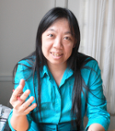-
P01: A Fixed Pattern Deviation Robot That Triggers Intention Attribution
Kazunori Terada, Yuto Imamura, Hideyuki Takahashi and Akira Ito
-
P02: The Sharing of Meta-Signals and Protocols Is the First Step for the Emergence of Cooperative Communication
Takakazu Mizuki, Akira Ito and Kazunori Terada
-
P03: FIONA: A Platform for Embodied Cognitive Agents
Celestino Alvarez and Lucía Fernández Cossío
-
P04: A Cooking Assistant Robot Using Intuitive Onomatopoetic Expressions and Joint Attention
Mutsuo Sano, Yuka Kanemoto, Syogo Noda, Kenzaburo Miyawaki and Nami Fukutome
-
P05: Synchrony Based Side by Side Walking: An Application in Human-Robot Interactions
Syed Khursheed Hasnain, Ghiles Mostafaoui, Caroline Grand and Philippe Gaussier
-
P06: Image Recognition Method Which Measures Angular Velocity from a Back of Hand for Developing a Valve UI
Hirotsugu Minowa
-
P07: Development of a Dialogue Scenario Editor on a Web Browser for a Spoken Dialogue System
Ryota Nishimura, Daisuke Yamamoto, Takahiro Uchiya and Ichi Takumi
-
P08: Notification Design Using Mother-like Expressions
Marie Uemura, Keiko Yamamoto, Itaru Kuramoto and Yoshihiro Tsujino
-
P09: Will You Follow the Robot’S Advice? The Impact of Robot Types and Task Types on People’s Perception of a Robot
Hyewon Lee, Jung Ju Choi and Sonya S. Kwak
-
P10: Multimodal Bodily Feeling Analysis to Design Air Conditioning Services for Elderly People
Shinya Kiriyama, Kenichi Shibata, Shogo Ishikawa, Kei Ogawa, Harunobu Nukushina and Yoichi Takebayashi
-
P11: Portable Robot Inspiring Walking in Elderly People
Yuri Kumahara and Yoshikazu Mori
-
P12: Can You Touch Me? The Impact of Physical Contact on Emotional Engagement with a Robot
Chaehyun Baek, Jung Ju Choi and Sonya S. Kwak
-
P13: Social Acceptance by Elderly People of a Fall-detection System with Range Sensors in a Nursing Home
Takamasa Iio, Masahiro Shiomi, Koji Kamei, Chandraprakash Sharma and Norihiro Hagita
-
P14: Preliminary Investigation of Supporting Child-Care at an Intelligent Playroom
Masahiro Shiomi and Norihiro Hagita
-
P15: Recovery of Virtual Object Contact Surface Features for Replaying Haptic Feeling
Yongyao Yan, Greg S. Ruthenbeck and Karen J. Reynolds
-
P16: Toward Playmate Robots That Can Play with Children Considering Personality
Kasumi Abe, Chie Hieida, Muhammad Attamimi, Takayuki Nagai, Takayuki Shimotomai, Takashi Omori and Natsuki Oka
-
P17: Affective Agents for Enhancing Emotional Experience
Takahiro Matsumoto, Shunichi Seko, Ryosuke Aoki, Akihiro Miyata, Tomoki Watanabe and Tomohiro Yamada
-
P18: The Hybrid Agent MARCO: A Multimodal Autonomous Robotic Chess Opponent
Christian Becker-Asano, Eduardo Meneses Bello, Nicolas Riesterer, Julien Hué, Christian Dornhege and Bernhard Nebel
-
P19: Artificial Endocrine System for Language Translation Robot
Wu Jhong Ren and Hooman Samani
-
P20: Pointing Gesture Prediction Using Minimum-Jerk Model in Human-Robot Interaction
Ren Ohmura, Yuki Kusano and Yuta Suzuki
-
P21: Digital Play Therapy for Children with Learning Disabilities
Yukako Watanabe, Yoshiko Okada, Hirotaka Osawa and Midori Sugaya
-
P22: Amae and Agency Appraisal as Japanese Emotional Behavior: Influences on Agent’s Believability
Koushi Mitarai and Hiroyuki Umemuro
-
P23: Weight-Aware Robot Motion Planning for Lift-to-Pass Action
Oskar Palinko, Alessandra Sciutti, Francesco Rea and Giulio Sandini
-
P24: Emotion Recognition and Expression in Therapeutic Social Robot Design
Sun Jie, Daniel Peng Zhuo, Li Qinpei, Anthony Wong Chern Yuen and Rui Yan
-
P25: Luminous Device for the Deaf and Hard of Hearing People
Akira Matsuda, Midori Sugaya and Hiroyuki Nakamura
-
P26: Development of Werewolf Match System for Human Players Mediated with Lifelike Agents
Yu Kobayashi, Hirotaka Osawa, Michimasa Inaba, Kosuke Shinoda, Fujio Toriumi and Daisuke Katagami
-
P27: Development of Smart Infant-Parents Affective Telepresence System
Elham Saadatian, Reihaneh Hosseinzadeh Hariri, Adrian David Cheok and Ryohei Nakatsu
-
P28: COLUMN: Persuasion as a Social Mediator to Establish the Interpersonal Coordination
Ysutaka Takeda, Kohei Yoshida, Shotaro Baba, Ravindra De Silva and Michio Okada
-
P29: Towards Better Eye Tracking in Human Robot Interaction Using an Affordable Active Vision System
Oskar Palinko, Alessandra Sciutti, Francesco Rea and Giulio Sandini
-
P30: Evaluation of a Video Communication System with Speech-Driven Embodied Entrainment Audience Characters with Partner’s Face
Yutaka Ishii and Tomio Watanabe
-
P31: Dynamic Dialog System for Human Robot Collaboration – Playing a Game of Pairs
Andreas Kipp and Franz Kummert
-
P32: Unification of Demonstrative Pronouns in a Small Group Guided by a Robot
Takashi Ichijo, Nagisa Munekata and Tetsuo Ono
-
P33: Evaluating an Intuitive Teleoperation Platform Explored in a Long-Distance Interview
Ritta Baddoura, Gentiane Venture and Guillaume Gibert
-
P34: AAnalysis of Personality Traits for Intervention Scene Detection in Multi-User Conversation
Shochi Otogi, Hung-Hsuan Huang, Ryo Hotta and Kyoji Kawagoe
-
P35: A Design Method Using Cooperative Principle for Conversational Agent
Masahide Yuasa
-
P36: Experimental Study of Empathy and Its Behavioral Indices in Human-Robot Interaction
Yuichiro Tsuji, Ami Tsukamoto, Takashi Uchida, Yusuke Hattori, Ryosuke Nishida, Chie Fukada, Motoyuki Ozeki, Takashi Omori, Takayuki Nagai and Natsuki Oka
-
P37: Huggable Communication Medium Encourages Listening to Others
Junya Nakanishi, Hidenobu Sumioka, Masahiro Shiomi, Daisukei Nakamichi, Kurima Sakai and Hiroshi Ishiguro
-
P38: Tap Model to Improve Input Accuracy of Touch Panels
Takahisa Tani and Seiji Yamada
-
P39: Modeling of Cooperative Behavior Agent Based on Collision Avoidance Decision Process
Kensuke Miyamoto, Hiroaki Yoshioka, Norifumi Watanabe and Yoshiyasu Takefuji
-
P40: Representation of Gaze, Mood, and Emotion: Movie-watching with Telepresence Robots
Ken Yonezawa and Hirotada Ueda
-
P41: A Hierarchical Structure for Gesture Recognition Using RGB-D Sensor
Hyunsoek Choi and Hyeyoung Park
-
P42: Communicating Emotions: A Model for Natural Emotions in HRI
Oliver Damm and Britta Wrede
-
P43: How Does Emphatic Emotion Emerge via Human-Robot Rhythmic Interaction?
Hideyuki Takahashi, Nobutsuna Endo, Hiroki Yokoyama, Takato Horii, Tomoyo Morita and Minoru Asada
-
P44: Determining Robot Gaze According to Participation Roles in Multiparty Conversations
Takashi Yoshino, Yuki Hayashi and Yukiko Nakano
-
P45: Interactions on Eyeballs of Humanoid-Robots
Takayuki Todo and Takanari Miisho
-
P46: Video-Based Emotion Identification Using Face Alignment and Support Vector Machines
Gil-Jin Jang, Ahra Jo and Jeong-Sik Park
-
P47: Social Networking Sites Photos and Robots: A Pilot Research on Facebook Photo Albums and Robotics Interfaces for Older Adults
Angie Lorena Marin
-
P48: Telepresence Robot That Exaggerates Non-Verbal Cues for Taking Turns in Multi-Party Teleconferences
Komei Hasegawa and Yasushi Nakauchi
-
P49: Emotional Scene Understanding Based on Acoustic Signals Using Adaptive Neuro-Fuzzy Inference System
Taewoong Kim and Minho Lee




